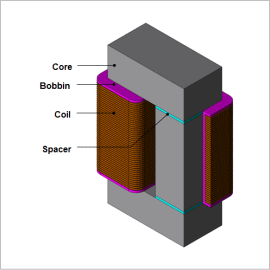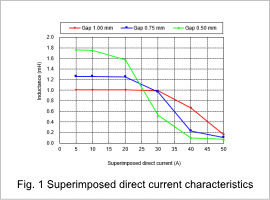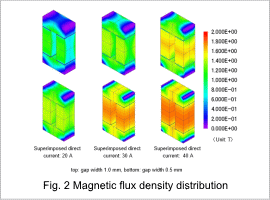*Please prepare a license ID and password for the license administrator.
*It is different from the service for JMAG WEB MEMBER (free membership). Please be careful.
Overview

A high-frequency reactor, used in equipment such as DC-DC converters, has a high-frequency current accompanying the switching direct current. The performance of a reactor is evaluated by a stable inductance in a wide direct current region. The gap that is designed to prevent magnetic saturation from the core largely affects the inductance, so it is a vital parameter of the reactor’s design.
The magnetic resistance is determined by the gap when there is a large gap width, which is used as a parameter for the superimposed direct current of the inductance. This means that the resistance can be evaluated using the magnetic circuit method, but when the gap width is small, the current is large, and magnetic saturation has a large effect on the inductance, an advance study using a finite element analysis (FEA) is an effective tool.
This Application Note explains a case example that obtains the superimposed direct current characteristics of a high-frequency reactor when the gap width is changed.
The magnetic resistance is determined by the gap when there is a large gap width, which is used as a parameter for the superimposed direct current of the inductance. This means that the resistance can be evaluated using the magnetic circuit method, but when the gap width is small, the current is large, and magnetic saturation has a large effect on the inductance, an advance study using a finite element analysis (FEA) is an effective tool.
This Application Note explains a case example that obtains the superimposed direct current characteristics of a high-frequency reactor when the gap width is changed.
Superimposed Direct Current Characteristics
From fig. 1, it is apparent that the inductance decreases more rapidly as the direct current increases. This is caused by influence from magnetic saturation, as shown in fig. 2. As the gap width grows larger, the gap becomes the dominant factor for magnetic resistance in the magnetic circuit, so the sensitivity of the inductance toward the current variation decreases.




